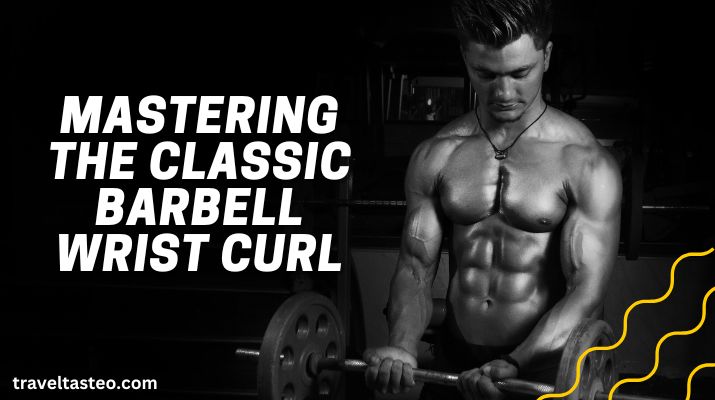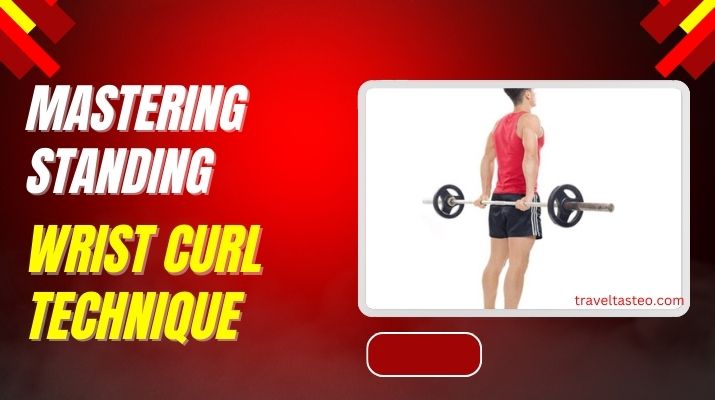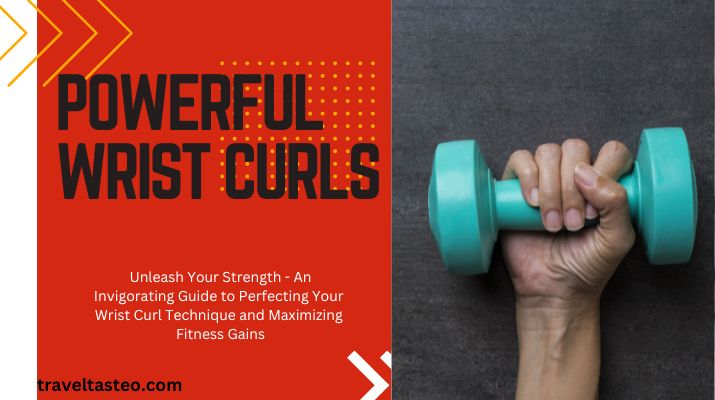Introduction
Every individual embarking on a fitness journey soon realizes that it’s not just the big muscles that matter. Often, smaller, more intricate exercises lead to comprehensive strength, stability, and functionality. Enter the Wrist Curl—an exercise that might seem simple at first glance but holds paramount significance in overall muscular development.
The wrist curl is a dedicated forearm exercise to strengthen the wrist flexor muscles. While many popular exercises focus on larger muscle groups like the chest, back, or legs, wrist curls work diligently on the more subtle yet incredibly vital forearm muscles. Why is this so significant? A robust wrist and forearm foundation contributes to a firmer grip, a prerequisite for many weight-bearing exercises.
Furthermore, wrist strength transcends the gym environment. The wrists play an instrumental role in our day-to-day lives, from lifting grocery bags to typing on a keyboard. For athletes, especially those in racquet sports, climbing, or gymnastics, wrist curls are not just another exercise—they are essential.
The beauty of the wrist curl is its versatility. Whether using a barbell, dumbbell, or even resistance bands, this exercise can be tailored to suit individual preferences and fitness levels.
As we navigate the depths of this exercise in the sections ahead, you’ll gain a profound understanding of its techniques, variations, and benefits. Whether you’re a fitness novice or a seasoned gym-goer, the wrist curl promises to be a game-changer in your regimen.
The Anatomy of a Perfect Wrist Curl
Much like the intricacies of a well-performed lunges exercise, the wrist curl has nuances and techniques that make all the difference. When done correctly, it can substantially amplify forearm strength and wrist mobility. Conversely, incorrect technique can lead to minimal gains and even potential injuries. So, how can one ensure they’re performing wrist curls to perfection?
How to Do a Wrist Curl: A Step-by-Step Guide
1. Starting Position: Begin by sitting on a bench with your feet planted firmly on the ground. Hold a dumbbell or barbell (based on preference) with an underhand grip, ensuring your hands are shoulder-width apart.
2. Wrist Positioning: Rest your forearms on your thighs or the bench’s edge, allowing your wrists and the weight to hang off the edge.
3. The Curl: Slowly curl the weight upwards without moving the arm using only your wrists. Make sure the movement is controlled, focusing on contracting the forearm muscles.
4. Peak Contraction: At the top of the movement, squeeze the forearm muscles for a moment, ensuring maximum muscle engagement.
5. Returning: Gradually lower the weight to the starting position, stretching the wrist flexors.
6. Repetitions: Starting with lighter weights is advisable for beginners, aiming for three sets of 12-15 reps. As strength and endurance build, one can increase the weight and adjust repetitions accordingly.
Remember, the key to mastering the wrist curl, or any exercise, lies in technique rather than the weight lifted. Maintaining a controlled motion throughout is crucial, avoiding any jerky or swift movements.
For those who frequently engage in exercises that require a strong foundation—like the sumo deadlift—incorporating wrist curls can offer a complementary strength boost, ensuring your grip doesn’t falter during those critical lifts.
Varieties in Wrist Curls: Exploring the Spectrum
The wrist curl is not a one-size-fits-all exercise. Depending on equipment availability, personal preference, or specific training goals, there’s a spectrum of wrist curl varieties. Let’s delve deeper into some of these variants, their techniques, and their unique advantages.
The Classic Barbell Wrist Curl

The barbell variant is perhaps the most popular form of wrist curl and offers an excellent way to work both wrists simultaneously.
Technique:
1. Sit on a bench and grasp a barbell with an underhand grip, hands spaced shoulder-width apart.
2. Rest your forearms on your thighs, letting the wrists hang off the edge.
3. Curl the barbell upwards using the wrists, then slowly lower it.
Advantages: The uniform weight distribution ensures that both wrists receive equal resistance, promoting balanced strength development.
Diversifying with the Dumbbell Wrist Curl
The dumbbell wrist curl allows one to isolate and work on each wrist separately, allowing greater focus on technique and form.

Technique:
1. Sit on a bench, holding a dumbbell in one hand.
2. Rest the forearm on the thigh, similar to the barbell technique.
3. Curl the dumbbell upwards, then return to the starting position.
Advantages: This variant allows for identifying and correcting any imbalances between the wrists. Additionally, it’s excellent for functional fitness as it mimics how we often lift objects in everyday life.
Benefits and Techniques of the Standing Wrist Curl
This is a variation for those who prefer to perform their wrist curls standing up, providing a slightly different engagement of the forearm muscles.

Technique:
1. Stand holding a barbell or dumbbell behind your back with an underhand grip.
2. Curl the weight upwards using only the wrists, then lower.
Advantages: Engages stabilizing muscles, offering a more comprehensive forearm workout. Plus, for those engaged in calisthenics, the standing posture aligns more with many functional movements.
The Precision of the Seated Barbell Wrist Curl
A variation that specifically focuses on precision and controlled movement, ideal for those recovering from injuries or seeking a more mindful exercise.
Technique:
- Sit on a bench, holding a barbell with palms facing downwards (overhand grip).
- Rest your forearms on your thighs, letting the wrists hang off the edge.
- Curl the weight downwards using the wrists, then slowly curl upwards.
Advantages: This overhand variant targets different parts of the forearm, offering a comprehensive workout and promoting balanced muscle development.
From the classic barbell curl to the precise seated version, there’s a wrist curl for every fitness enthusiast. Experiment with these variants to discover which aligns best with your fitness goals and offers the most comfort.
Flipping it with the Reverse Wrist Curl
The reverse wrist curl is an excellent variant to target the extensor muscles on the forearm’s backside. Often neglected, these muscles balance forearm development and ensure joint stability.
Technique:
1. Sit on a bench and grasp a barbell with an overhand grip, hands spaced shoulder-width apart.
2. Gently lay your forearms upon your thighs, allowing your wrists to dangle over the precipice gracefully.
3. Lifting the barbell by extending your wrists keeping the arms stationary. Slowly lower to the starting position.
Advantages: Directly targets the extensor muscles, providing balanced forearm strength and reducing the risk of injuries associated with muscle imbalances.
The Underestimated Palms-Down Wrist Curl
The palms-down wrist curl is a nuanced exercise that focuses on the finer muscles of the forearm, offering a different kind of stimulation than its counterparts.

Technique:
- Sit down with a dumbbell in each hand, palms facing downwards.
- Rest your forearms on your thighs, allowing your wrists to hang over the edge.
- Curl the weights downwards, then slowly raise them as high as possible.
Advantages: This movement, while seemingly subtle, gives an intense workout to the often-neglected muscles, ensuring a comprehensive forearm routine. It also adds variety, keeping the workout interesting.
Delving into the Wrist Curl Overhand
The wrist curl overhand can be viewed as a hybrid of the two previous exercises, combining their benefits into one cohesive movement.

Technique:
1. Sit on a bench and take a barbell with an overhand grip.
2. As with the previous techniques, rest your forearms on your thighs, letting the wrists hang freely.
3. Curl the barbell upwards using only the wrists, ensuring a controlled movement.
Advantages: This variation engages both the flexor and extensor muscles of the forearm. It’s excellent for those who want to ensure an even development and strengthen the wrists for exercises like the Bulgarian squat, where grip stability is paramount.
Incorporating these wrist curl variations ensures a holistic approach to forearm training. They bring about muscle balance and equip the individual with a firmer grip and enhanced wrist mobility, both of which are invaluable in various athletic and everyday tasks.
Maximizing Gains: Benefits of Wrist Curls
Wrist curls might seem simple, but they pack a punch regarding benefits. With consistent training, they can significantly enhance your forearm musculature and improve grip strength.
Why Incorporating Different Wrist Curls Elevates Your Training:
- Muscle Activation: Different wrist curl variations target unique muscle groups in the forearm, leading to balanced muscle development.
- Improved Grip Strength: Essential for lifting heavier weights in exercises like deadlifts, as highlighted in our sumo deadlift guide.
- Enhanced Muscle Endurance: Regular wrist curls boost endurance, aiding in exercises that require prolonged grip, such as pull-ups.
Common Blunders in Wrist Curls and Their Corrections
From Grip to Posture: Steering Clear of Mistakes:
· Incorrect Grip: Using a wide or narrow grip can strain the wrists. It’s essential to maintain a grip where the hands are shoulder-width apart.
· Using Excessive Weight: Starting with a weight too heavy can lead to poor form and wrist strain. It’s better to start light and gradually increase the weight.
· Not Using Full Range of Motion: Ensure the wrist moves through its entire range, from full flexion to full extension.
To Grip or Not to Grip: Understanding Wrist Curl Grips
The outcome of wrist curls can undergo a remarkable transformation depending on the tenacity of one’s grasp.
The Debate: Overhand vs. Underhand in Wrist Curls:
· Underhand Grip (Palms Up): This grip primarily targets the wrist flexors the muscles on the palm side of the forearm.
· Overhand Grip (Palms Down): This grip challenges the wrist extensors, muscles located on the backside of the forearm. Consider checking out hyperextension exercises that use a similar principle for a more in-depth dive into overhand grips.
Enhancing Strength with the Barbell Wrist Curl Overhand
Diving deeper into the overhand grip, the barbell wrist curl overhand stands out for its unique benefits:
1. Balanced Forearm Development: Targets flexor and extensor muscles, ensuring even muscle growth.
2. Greater Stability: The overhand grip challenges wrist stability, leading to better control in other weightlifting exercises.
3. Versatility: This can be integrated into various workout routines for increased forearm strength and endurance.
By understanding the intricacies and benefits of wrist curls, one can effectively integrate them into their fitness routine. These exercises enhance forearm aesthetics and play a pivotal role in improving overall lifting capabilities.
Alternative Training Methods and Equipment
Wrist Curl Alternatives: Diversifying Your Routine
Wrist curls are foundational, but introducing variety can spur new muscle growth and tackle plateaus. Alternatives include:
· Farmer’s Walk: An excellent exercise for forearm endurance. You indirectly engage your forearm muscles by walking while holding heavy dumbbells or kettlebells.
· Plate Pinches: Holding weight plates using just fingertips provides a unique challenge to the forearm muscles and enhances grip strength.
The Flexibility of Wrist Curls with Resistance Bands
Resistance bands offer an adaptable and versatile tool for wrist training.
· Benefits: Ideal for individuals who travel or don’t have access to weights. They offer variable resistance, making them suitable for beginners and veterans alike.
· Technique: Secure the band under your foot and hold the other end with your hand. Perform wrist curls, ensuring tension throughout the movement.
Machines and Their Role in Wrist Curls

Gym machines designed for forearm exercises ensure guided and isolated movements, reducing the risk of injuries.
· Wrist Curl Machines: These allow for consistent resistance during flexion and extension, aiding in balanced muscle development.
· Cable Machines: Attaching handles or rope attachments can be used for wrist curls, ensuring constant tension.
Barbells vs. Dumbbells: The Battle of Equipment

Both barbells and dumbbells have their merits in forearm training.
· Barbells: Allow lifting heavier loads, leading to increased muscle mass. They also ensure uniform work for both wrists.
· Dumbbells: Offer a more significant range of motion and help identify and correct muscle imbalances between the two arms.
Evaluating Efficiency, Suitability, and Results
Not every piece of equipment or method is suitable for everyone. It’s essential to:
· Assess your fitness level: Beginners might find bands more accommodating, while seasoned lifters may prefer barbells.
· Consider your goals: For hypertrophy, weights are preferable. For rehabilitation or endurance, bands or machines might be more suitable.
Prioritizing Safety in Wrist Curls
With any exercise, safety is paramount.
· Use Proper Form: Craft your sentence with a distinct flair, employing proper techniques that ward off the specter of strains and injuries.
· Avoid Overloading: Lifting too heavy too soon can lead to wrist pain or even chronic injuries.
Ensuring Healthy Wrists in Weight Training
To maximize gains and minimize risks:
· Warm-Up: Before diving into wrist exercises, ensure a proper warm-up to get blood flowing into the wrist joint.
· Stretch Regularly: Flexion and extension stretch keep the wrists limber and help them recover.
Preventative Measures and Why They’re Crucial
· Strength Balance: Ensure flexors and extensors are equally strong to prevent imbalances.
· Listen to Your Body: If you feel any sharp pain, it’s essential to stop and assess. Chronic wrist pain can impede daily activities, so being proactive in prevention is vital.
The variety of equipment and methods available for wrist training allows individuals to customize their routines. One can ensure consistent progress and healthy wrists by prioritizing safety and being informed about each tool’s benefits.
Embracing Wrist Curls: The Path to Robust Forearms and Wrists
After an extensive dive into the intricacies of wrist curls, their variations, and their immense benefits, it’s evident that this seemingly simple exercise holds a prominent place in the realm of fitness. Wrist curls, though often overlooked, serve as a foundational block for building robust and resilient forearms and wrists.
The journey through the different facets of this exercise highlights its versatility. From the classic barbell approach to the dynamic resistance bands and advanced machines, wrist curls offer something for everyone. Whether you’re just stepping into the world of fitness or a seasoned athlete, incorporating wrist curls and their variants can be a game-changer.
Moreover, the emphasis on safety, prevention, and technique underlines the importance of performing each repetition precisely. It’s not about how much you lift but how you lift it. With the right approach, the wrist curl can elevate your training, enhance your grip strength, and provide that sculpted look to your forearms that many desire. In essence, embracing wrist curls is not just about aesthetics or lifting prowess. It’s about functional strength. It’s about ensuring that the wrists and forearms, which play a role in almost every lifting movement, are fortified and resilient. As with all things in fitness, consistency, dedication, and informed choices lead the way. So, the next time you’re in the gym or at home planning your workout, give wrist curls the spotlight they deserve. Embrace them, and watch as they pave the path to stronger forearms and healthier wrists.
Frequently Asked Questions (FAQs) about Wrist Curls
What muscles do wrist curls target?
Wrist curls, with their focused intent, zero in on the forearm’s intricate network of muscles, singling out the flexor carpi radialis and flexor carpi ulnaris for a vigorous workout. When the tables turn to the reverse wrist curl, the extensor muscles of the forearm awaken from their slumber, ready to embrace the challenge.
How often should I incorporate wrist curls into my routine?
For optimal results, it’s recommended to incorporate wrist curls 2-3 times a week, ensuring adequate rest days in between to promote muscle recovery.
Can wrist curls help improve grip strength?
Yes, wrist curls can significantly improve grip strength by strengthening the forearm muscles, which are crucial for holding and lifting objects.
Are dumbbell wrist curls better than barbell wrist curls?
Both dumbbell and barbell wrist curls have their merits. Dumbbells offer more freedom of movement and can help identify muscle imbalances, while barbells allow for heavier loads and uniform work for both wrists.
I experienced wrist pain during the exercise. What should I do?
If you experience pain, it’s essential to stop immediately. Ensure you’re using proper form and not lifting too heavy. If the pain persists, consult with a fitness professional or physical therapist.

